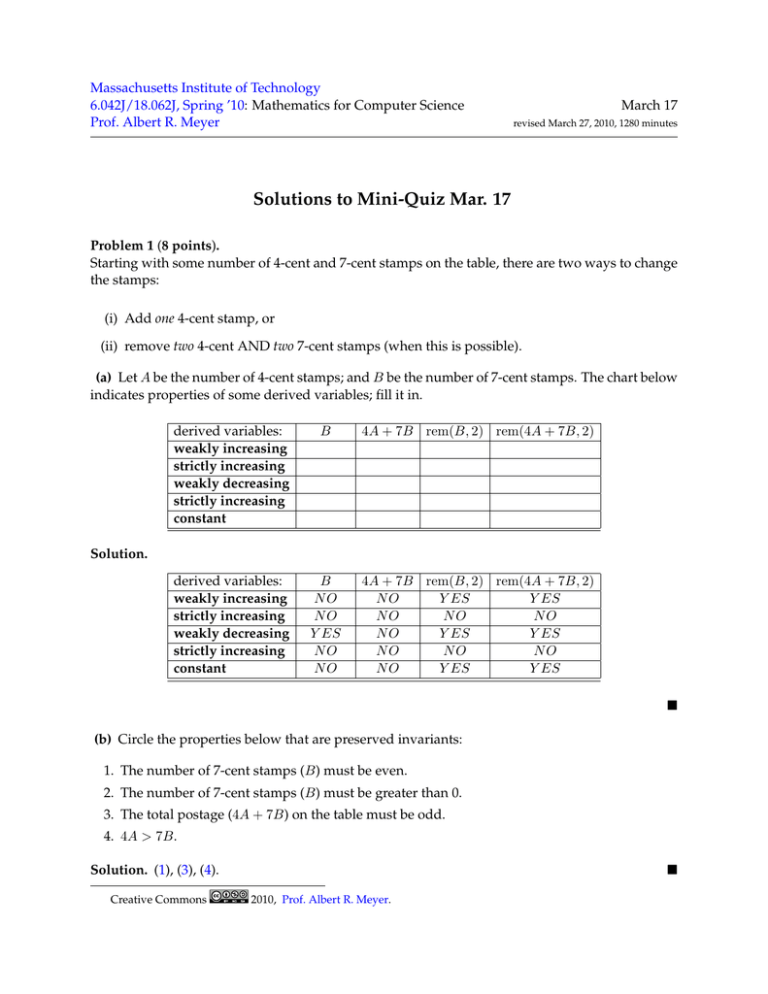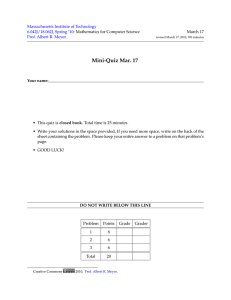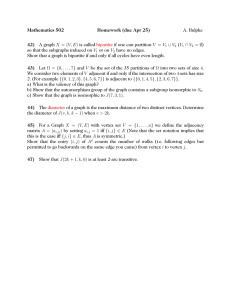Document 13440905
advertisement

Massachusetts Institute of Technology
6.042J/18.062J, Spring ’10: Mathematics for Computer Science
Prof. Albert R. Meyer
March 17
revised March 27, 2010, 1280 minutes
Solutions to Mini-Quiz Mar. 17
Problem 1 (8 points).
Starting with some number of 4-cent and 7-cent stamps on the table, there are two ways to change
the stamps:
(i) Add one 4-cent stamp, or
(ii) remove two 4-cent AND two 7-cent stamps (when this is possible).
(a) Let A be the number of 4-cent stamps; and B be the number of 7-cent stamps. The chart below
indicates properties of some derived variables; fill it in.
derived variables:
weakly increasing
strictly increasing
weakly decreasing
strictly increasing
constant
B
4A + 7B rem(B, 2) rem(4A + 7B, 2)
derived variables:
weakly increasing
strictly increasing
weakly decreasing
strictly increasing
constant
B
NO
NO
Y ES
NO
NO
4A + 7B rem(B, 2) rem(4A + 7B, 2)
NO
Y ES
Y ES
NO
NO
NO
NO
Y ES
Y ES
NO
NO
NO
NO
Y ES
Y ES
Solution.
�
(b) Circle the properties below that are preserved invariants:
1. The number of 7-cent stamps (B) must be even.
2. The number of 7-cent stamps (B) must be greater than 0.
3. The total postage (4A + 7B) on the table must be odd.
4. 4A > 7B.
Solution. (1), (3), (4).
Creative Commons
�
2010, Prof. Albert R. Meyer.
2
Solutions to Mini-Quiz Mar. 17
(c) Using the Invariant Principle, show that it is impossible to have stamps with a total value of
exactly 90 cents on the table when we start with exactly 211 7-cent stamps. (You may use without
proof the preserved invariance of some of the properties from part (b).)
Solution. We will show that the predicate (3) must hold for all reachable states of the state ma­
chine.
First, we check that the predicate holds for the start state:
rem(211 · 7 + 0 · 4, 2) = rem(1477, 2) = 1
So the total cost of stamps was clearly odd in the start state.
Since (3) is a preserved invariant that holds for the start state, it must hold for all reachable states
of the machine.
However, since the predicate does not hold for the state of having exactly 90 cents, it is not a reach­
able state and it is therefore impossible to have exactly 90 cents on the table.
�
Problem 2 (6 points).
Covering edges were introduced in class problem: if a and b are distinct vertices of a digraph, then
a is said to cover b if there is an edge from a to b and every path from a to b traverses this edge. If a
covers b, the edge from a to b is called a covering edge.
Let D be a finite directed acyclic graph (DAG).
(a) If there is a path in D from a vertex, u, to vertex, v, explain why there must be a longest path
from u to v.
Solution. If D has m vertices, then no path can be longer m − 1 —otherwise some vertex must
repeat on the path, which means there would be a cycle, contradicting the fact that D is a DAG. So
there must be a longest path from u to v. (Technically, this follows from the Well Ordering Principle
applied to the set {v − n ∈ N | there is a path of length n from u to v}.)
�
(b) Give a proof of the following claim from the class problem:
Claim. If there is a path in D from a vertex, u, to vertex, v, then there is a path from u to v that only
traverses covering edges.
Solution. By part (a), there is a longest path from u to v. If some edge on this path was not a
covering edge, then by definition there is a path of length 2 or more between its endpoints, and
replacing this edge by the path would yield a longer path from u to v, a contradiction. Hence all
edges must be covering edges.
�
(c) Show that the Claim fails for the finite digraph, F , with three vertices and edges from every
vertex to every other vertex. Hint: What are the covering edges of F ?
Solution. There are no covering edges in F , since for each edge u → v there is a length 2 path uwv
through the remaining vertex, w, that does not traverse this edge. So there is no path of covering
edges from any vertex to any other vertex.
�
Solutions to Mini-Quiz Mar. 17
3
Problem 3 (6 points).
Let G be a connected simple graph. Prove that if an edge in a connected graph is not traversed by
any simple cycle, then it is a cut edge.1
Solution. Proof. Supppose edge u—v is not a cut-edge. We show that it must be traversed by a
simple cycle.
Since the edge is not a cut-edge, the graph obtained by removing the edge is connected. So there
exists a path from u to v which does not traverse u—v. We proved in lecture that the shortest such
path from u to v must be simple. But this simple path together with u—v is a simple cycle that
traverses u—v.
�
1
A simple cycle is a subgraph of G isomorphic to the cycle graph Cn for n ≥ 3. An edge is a cut-edge when removing
the edge disconnects the graph.
MIT OpenCourseWare
http://ocw.mit.edu
6.042J / 18.062J Mathematics for Computer Science
Spring 2010
For information about citing these materials or our Terms of Use, visit: http://ocw.mit.edu/terms.





